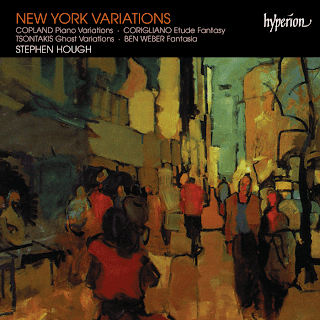 I've been travelling and working intensely over the past two weeks so very little came of listening. The best I could do was to snatch a few bits in a train compartment or in a hotel lobby. Whilst travelling I'm unlikely to listen to unfamiliar or difficult music. This time I had two travelling companions in the form of a Hovhaness collection for harp I transferred from my father's collection to my iPad and the Autumn Chorus CD (The Village to the Vale) I downloaded earlier this year. The latter I find still a magnificent piece of work and an astonishing feat for a first recording. My favourite track is certainly the epic, 16 minute long Rosa. A gorgeous wash of sound, particularly when you are looking out of a train window whilst travelling through central Sweden on a bright midsummer evening ... Autumn Chorus produce a sound that is hybrid between the Moody Blues and Sigur Ros. I just love it.
I've been travelling and working intensely over the past two weeks so very little came of listening. The best I could do was to snatch a few bits in a train compartment or in a hotel lobby. Whilst travelling I'm unlikely to listen to unfamiliar or difficult music. This time I had two travelling companions in the form of a Hovhaness collection for harp I transferred from my father's collection to my iPad and the Autumn Chorus CD (The Village to the Vale) I downloaded earlier this year. The latter I find still a magnificent piece of work and an astonishing feat for a first recording. My favourite track is certainly the epic, 16 minute long Rosa. A gorgeous wash of sound, particularly when you are looking out of a train window whilst travelling through central Sweden on a bright midsummer evening ... Autumn Chorus produce a sound that is hybrid between the Moody Blues and Sigur Ros. I just love it. The Hovhaness CD (a Telarc production from 2005) offers a mix of pieces for harp and various ensembles. There is a Concerto for Harp and String Orchestra (with the orchestra part played by I Fiamminghi) which I haven't really listened to yet. The excellent soloist is Yolanda Kondonassis. I keep returning to the Sonata for Harp solo and a Sonata for Guitar and Harp 'Spirit of Trees'. It's not particularly probing music, but the faintly orientalising harmonies and haunting sonorities offer a contemplative bubble to escape from the buzz of airports and planes.
I'll be leaving soon on an extended bicycle tour through France, as an opportunity to learn more about the future of Europe. I have my iPad with me, loaded with a number of new CDs. It remains to be seen to what extent I'll be in the mood for listening on this challenging tour.





